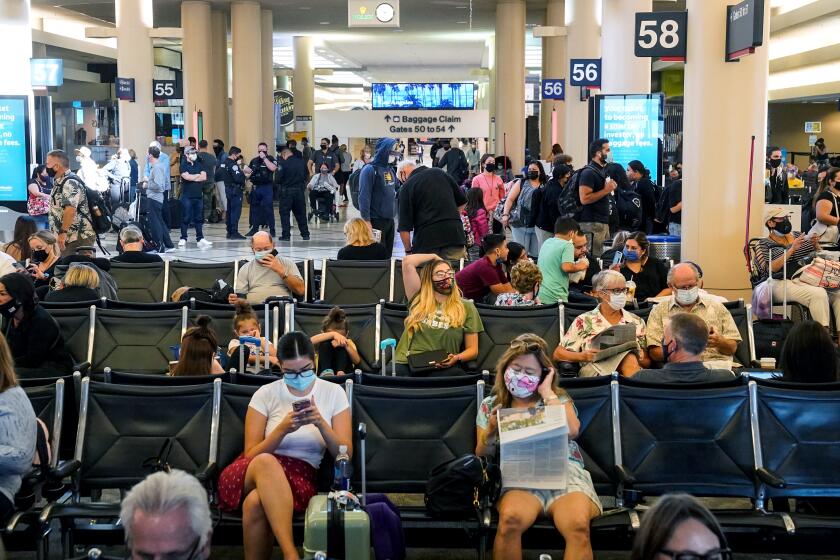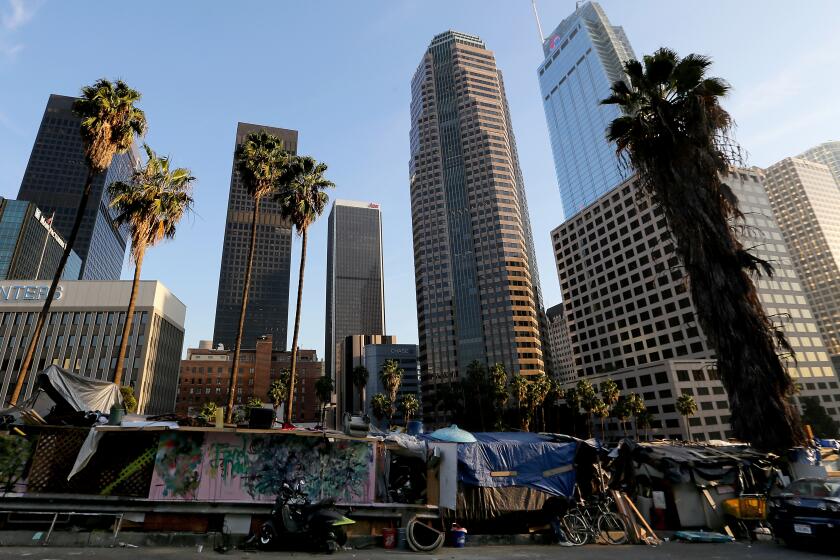California economy is fast losing momentum; 327,600 give up on seeking jobs

Hundreds of thousands of Californians dropped out of the workforce in November as businesses sharply curtailed the pace of hiring — trends that economists suggest are growing ever more dire.
Golden State employers added 57,100 jobs last month, bringing payrolls to a total of 16.19 million, California officials reported Friday. That was a dramatic slowdown from the previous month: In October, when hopes were high that the COVID-19 pandemic was abating, payrolls grew by 145,600.
“This was the lowest job gain since the recovery began,” said Taner Osman, research manager at Beacon Economics, a Los Angeles consultancy. Given this year’s devastation, he said, “adding 57,000 jobs is a drop in the ocean.”
California has regained fewer than half of the more than 2.6 million nonfarming jobs it lost in March and April because of the COVID-19 pandemic.
The state’s unemployment rate fell to 8.2% in November. That’s down from 9% in October but exceeds the nationwide rate of 6.7%.
But the jobless rate counts only people who are actively looking for work. Economists said November’s drop reflected a massive exodus of Californians from the labor force: 327,600 who had stopped seeking employment.
The lucky among California’s small businesses have cobbled together loans and grants to get through the pandemic so far. But that money has dried up, and “you can only take on so much debt.”
“California’s economy lost momentum in November as COVID infections started to climb and federal support programs ran dry,” said Lynn Reaser, an economist at San Diego’s Point Loma Nazarene University.
Monthly changes in labor force can be volatile, “but the pandemic’s overall impact has been stark,” Reaser said. “As of November, California’s labor force was down a striking 627,000 from its February level.”
Women, many of whom have taken leave to care for children and elderly family members, account for two-thirds of the drop in the labor force, according to Pomona College economist Fernando Lozano. “And the data suggest that the largest change in the labor force participation is among persons with a college degree or more education,” he said.
Cumulative cases of the coronavirus in California have soared from about 870,000 in mid-October to more than 1.7 million this week, according to data from The Times. As of Friday, the number is on pace to double every 30.6 days.
The November jobs numbers are based on surveys taken during the second week of the month and do not reflect stricter lockdowns that began in December. Most of the state’s population is now under stay-at-home orders. Thousands of businesses have shut, and others are limping along under restrictions to limit the number of customers at any one time.
Job postings in California are down 23% since January, and small-business openings and revenue are both down 28%, according to Opportunity Insights, an economic research group based at Harvard University.
In the first two weeks of December, more than 380,000 Californians filed new unemployment claims.
The state accounted for more than a fifth of U.S. claims, despite having just 11% of the nation’s civilian labor force.
“California is falling further behind the rest of the nation in employment,” said Michael Bernick, a former director of the California Employment Development Department who tracks jobs data. “No government program at this point will turn around hiring until the schools reopen, businesses reopen, and immunization is widely achieved.”
After “a gloomy COVID winter,” widespread vaccination will bring years of robust growth to California’s economy, the UCLA Anderson forecast says.
Economists say California’s recovery will depend to a great extent on two factors: the success of a mass vaccination program and the generosity of federal aid for millions of unemployed workers, teetering businesses and cash-strapped state and local governments.
With federal programs covering 750,000 jobless Californians set to expire late this month, congressional leaders this week were furiously negotiating a $900-billion package, but economists say additional relief will be needed by early next year to jump-start a full recovery.
“More temporary layoffs are turning into permanent job losses,” said Sung Won Sohn, an economist at Loyola Marymount University. The “virus wave, the lack of fiscal stimulus and soft holiday sales could knock the economy into another dip during the fourth quarter before the vaccine and additional stimulus from Washington come to rescue.”
In November, the state’s leisure and hospitality sector grew by 27,800 jobs, the most of any industry group, reflecting in part an expansion of takeout, delivery and outdoor dining. But now, with bans on outdoor dining and winter weather setting in, many restaurants cannot afford to remain open.
The trade, transportation and utilities sector added the second-largest number of positions: 19,700. Grocery stores helped boost retail jobs, and as many Californians avoided shopping in person, online orders for goods fueled a gain in trucking and warehouse positions.
But “with renewed stay-at-home orders and severe business restrictions once again being enforced, the job revival in these sectors in October and November appears fragile and unsustainable,” said Scott Anderson, a Bank of the West economist. “We expect big job declines to reappear in these industries in December as furloughs and layoffs once again come home to roost.”
Construction shrank by 5,800 jobs last month. The government sector lost 10,200 jobs, mainly due to the expiration of temporary Census hires.
White and higher-income Californians are most likely to believe today’s children will be worse off than their parents, a new statewide survey finds.
Los Angeles County gained 29,800 jobs in November, bringing payrolls to a total of about 4.26 million. The largest gain (22,700) was in trade, transportation and utilities. The largest loss was in construction, which shrank by 3,300.
Los Angeles County’s unemployment rate dropped to 11% from October’s 12% as its labor force fell by 94,000 workers.
Orange County payrolls grew by 16,500 jobs in November, totaling about 1.56 million. Its largest gains were in the arts, entertainment and recreation sector (9,100) and in retail trade (6,100). The construction sector was the biggest decliner, shedding 3,100 jobs.
Its unemployment rate was 6.4%, down from 7.3% in October, as its labor force dropped by 28,900.
In Riverside and San Bernardino Counties, November payrolls grew by 17,200 jobs to about 1.46 million. Trade, transportation and utilities added the most jobs (15,600) while education and health services lost the most: 2,700.
Unemployment in the Inland Empire counties fell to 7.9% from October’s 8.7% as the labor force dropped by 31,100.
More to Read
Inside the business of entertainment
The Wide Shot brings you news, analysis and insights on everything from streaming wars to production — and what it all means for the future.
You may occasionally receive promotional content from the Los Angeles Times.














